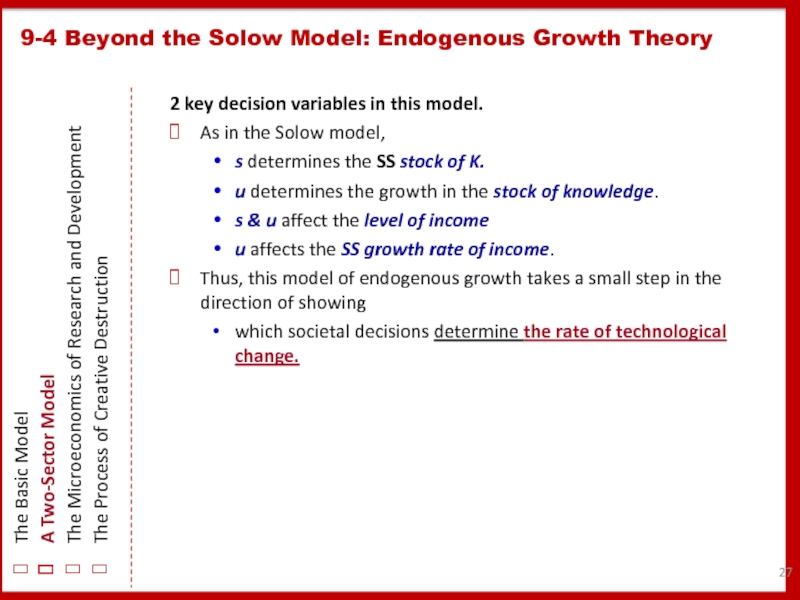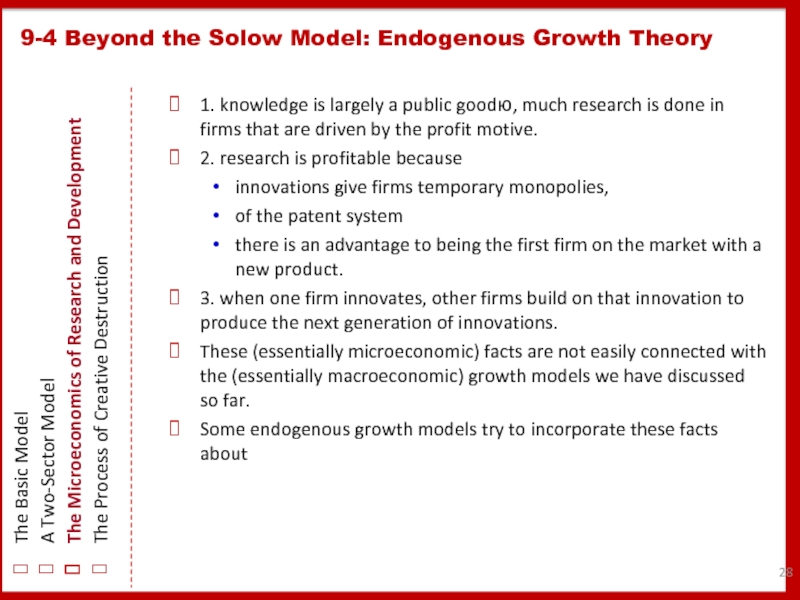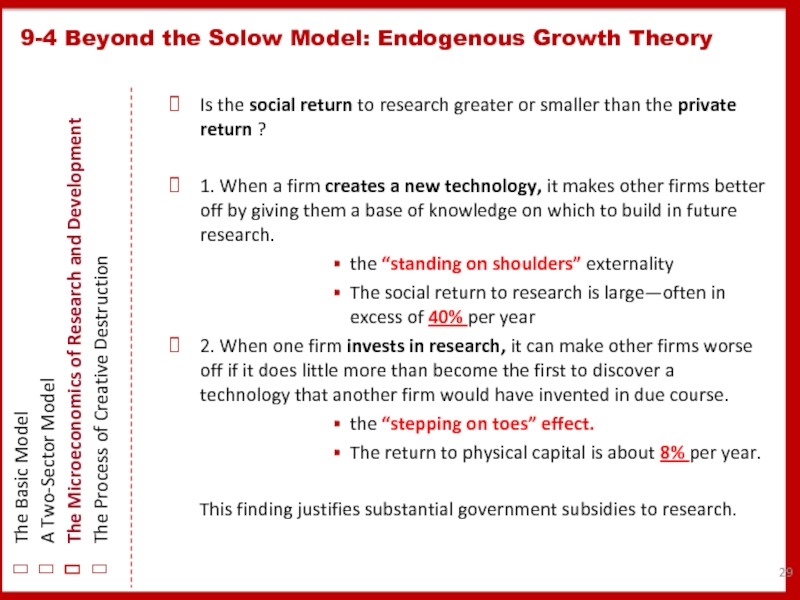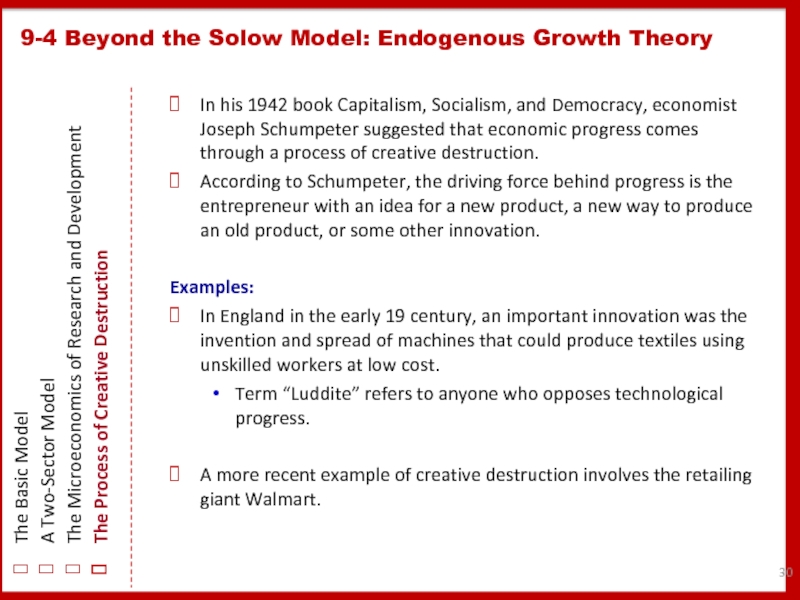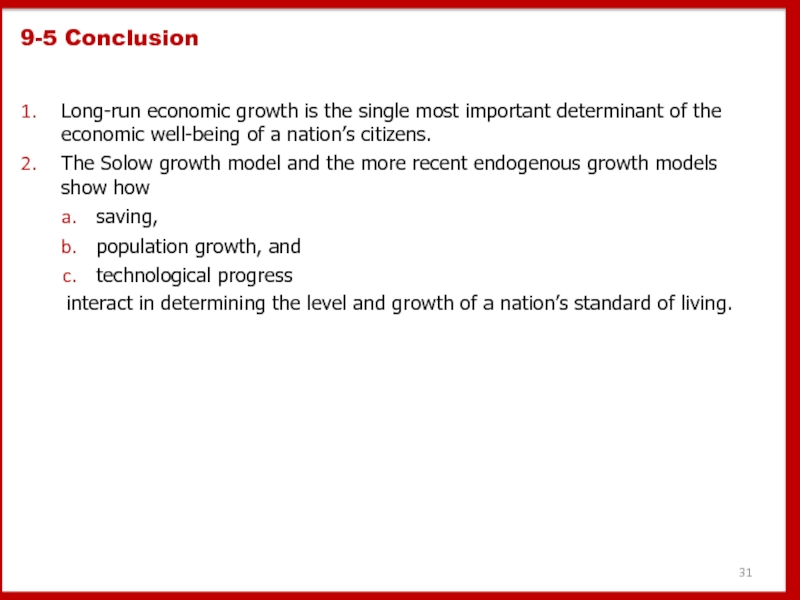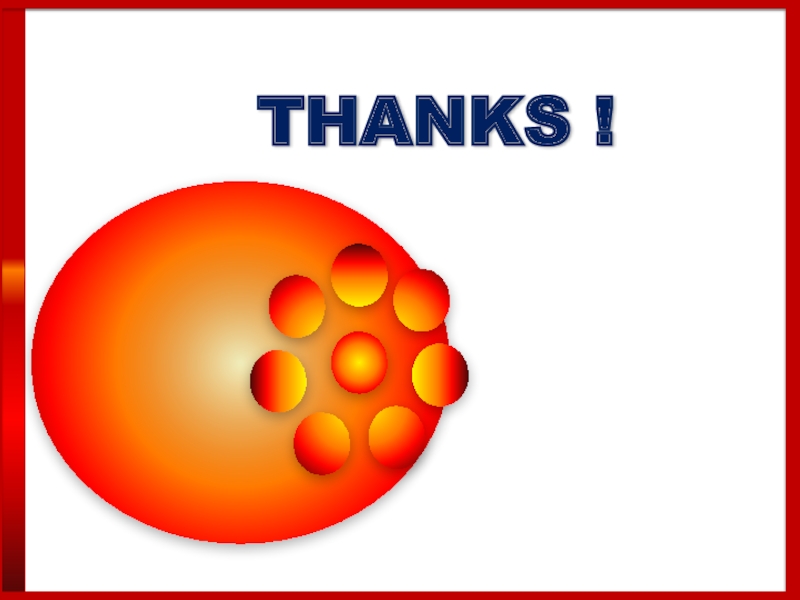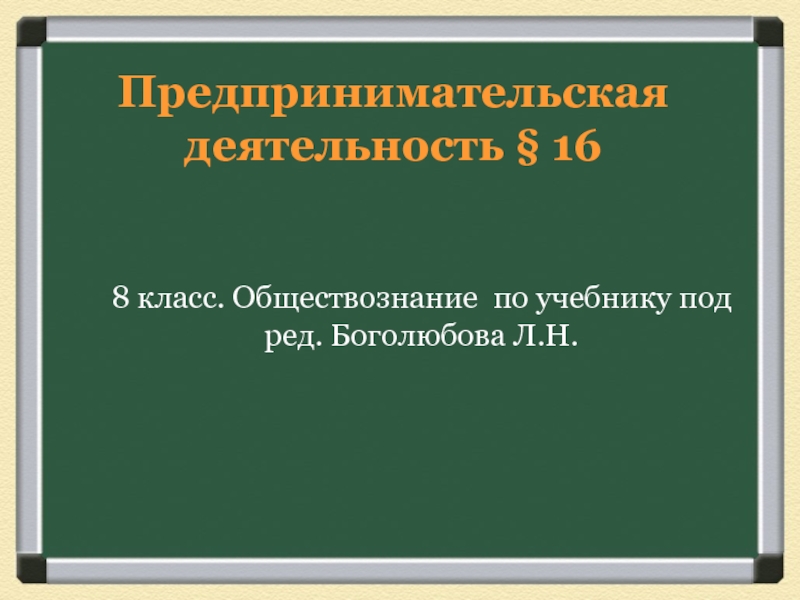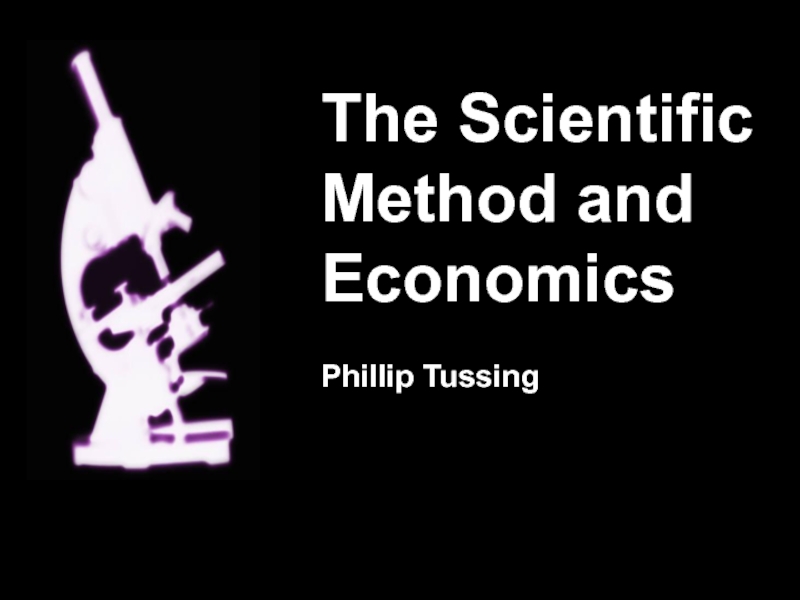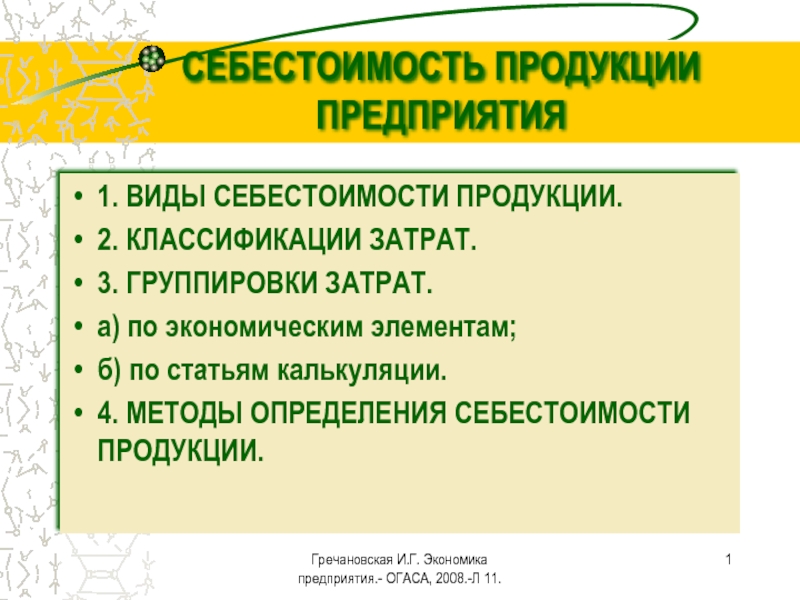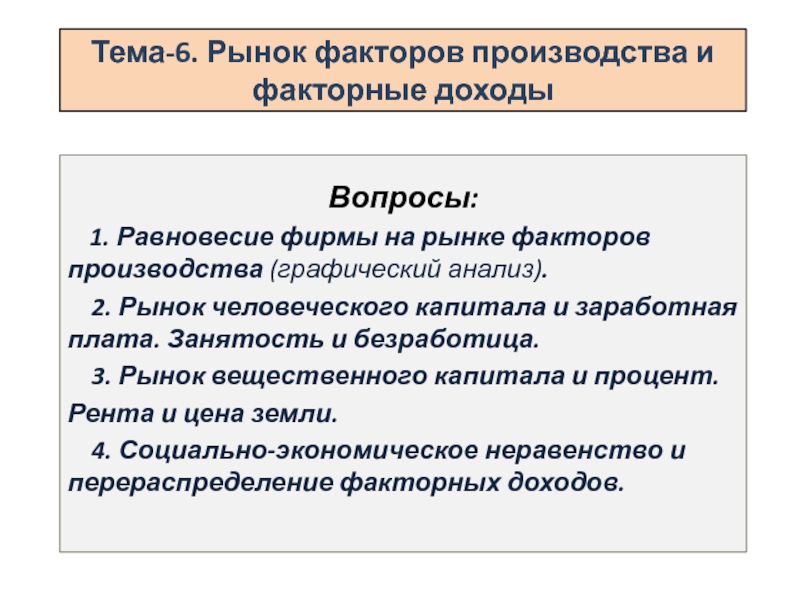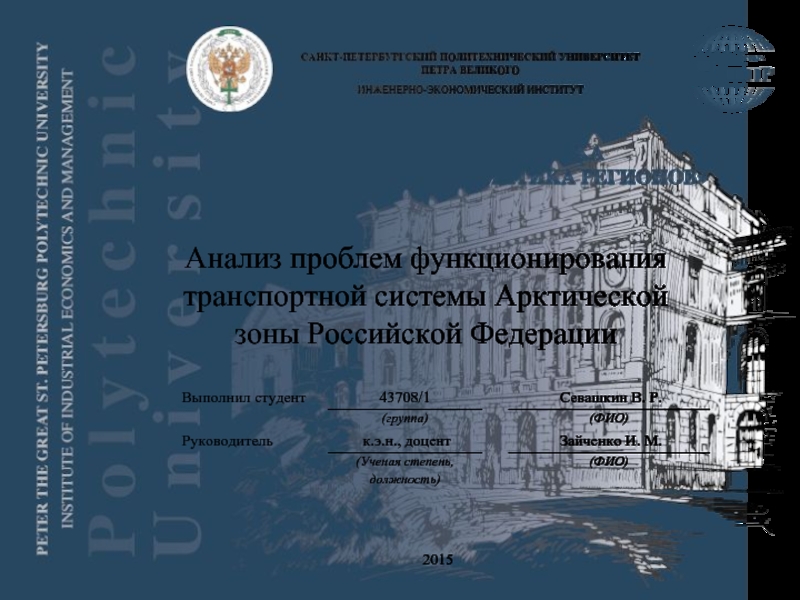- Главная
- Разное
- Дизайн
- Бизнес и предпринимательство
- Аналитика
- Образование
- Развлечения
- Красота и здоровье
- Финансы
- Государство
- Путешествия
- Спорт
- Недвижимость
- Армия
- Графика
- Культурология
- Еда и кулинария
- Лингвистика
- Английский язык
- Астрономия
- Алгебра
- Биология
- География
- Детские презентации
- Информатика
- История
- Литература
- Маркетинг
- Математика
- Медицина
- Менеджмент
- Музыка
- МХК
- Немецкий язык
- ОБЖ
- Обществознание
- Окружающий мир
- Педагогика
- Русский язык
- Технология
- Физика
- Философия
- Химия
- Шаблоны, картинки для презентаций
- Экология
- Экономика
- Юриспруденция
Economic growth. Technology, empirics, and policy презентация
Содержание
- 1. Economic growth. Technology, empirics, and policy
- 2. 9-1 Technological Progress in the
- 3. Our analysis of the forces governing long-run
- 4. 9-1 Technological Progress in the Solow
- 5. Because T/LP is modeled here as labor
- 6. 9-1 Technological Progress in the Solow Model
- 7. 9-1 Technological Progress in the Solow Model
- 8. 9-2 From Growth Theory to Growth Empirics
- 9. 9-2 From Growth Theory to Growth Empirics
- 10. 9-2 From Growth Theory to Growth Empirics
- 11. 9-2 From Growth Theory to Growth Empirics
- 12. 9-2 From Growth Theory to Growth Empirics
- 13. At least since Adam Smith, economists have
- 14. The U.S. economy is at, above, or
- 15. Example: Real GDP in the U.S.
- 16. 9-3 Policies to Promote Growth Evaluating the
- 17. 9-3 Policies to Promote Growth Evaluating the
- 18. 9-3 Policies to Promote Growth Evaluating the
- 19. 9-3 Policies to Promote Growth Evaluating the
- 20. Policymakers and economists have long debated whether
- 21. 9-3 Policies to Promote Growth Evaluating the
- 22. International data show a remarkable correlation between
- 23. 9-3 Policies to Promote Growth Evaluating the
- 24. Measurement Problems For instance, if
- 25. Endogenous Growth Theory reject the Solow model’s
- 26. Y = F[K, (1 − u)LE] (PF
- 27. 2 key decision variables in this model.
- 28. 1. knowledge is largely a public goodю,
- 29. 9-4 Beyond the Solow Model: Endogenous Growth
- 30. In his 1942 book Capitalism, Socialism, and
- 31. 9-5 Conclusion Long-run economic growth is the
Слайд 2
9-1 Technological Progress in the Solow Model
9-2 From Growth Theory
9-3 Policies to Promote Growth
9-4 Beyond the Solow Model: Endogenous Growth Theory
9-5 Conclusion
Слайд 3Our analysis of the forces governing long-run growth
Tasks:
1st to make the
The Solow model does not explain technological progress but, instead, takes it as exogenously.
2nd to move from theory to empirics.
The Solow model can shed much light on international growth experiences, but it is far from the last word on the subject.
3d to examine how a nation’s public policies can infl uence the level and growth of its citizens’ standard of living.
Should our society save more or less?
How can policy infl uence the rate of saving?
Are there some types of investment that policy should especially encourage?
What institutions ensure that the economy’s resources are put to their best use?
How can policy increase the rate of TLP?
The Solow growth model provides the theoretical framework within which we consider these policy issues.
4th to consider what the Solow model leaves out.
We examine a new set of theories, called endogenous growth theories, which help to explain the TLP that the Solow model takes as exogenous.
Слайд 4
9-1 Technological Progress in the Solow Model
The Efficiency of Labor
The
The Effects of Technological Progress
Слайд 5Because T/LP is modeled here as labor augmenting, it fits into
When there was no T/LP, we analyzed the economy in terms of quantities per worker;
We now let
k = K/(L × E) stand for capital per effective worker
y = Y/(L × E) stand for output per effective worker.
=> y = f(k).
Δk = sf(k) − (δ + n + g)k.
to keep k constant,
δk is needed to replace depreciating capital,
nk is needed to provide capital for new workers,
gk is needed to provide capital for the new “effective workers” created by T/LP.
9-1 Technological Progress in the Solow Model
The Efficiency of Labor
The Steady State With Technological Progress
The Effects of Technological Progress
Слайд 69-1 Technological Progress in the Solow Model
The Efficiency of Labor
The
The Effects of Technological Progress
T/LP
the Solow Growth Model
Now that k is defined
as the amount of capital per
effective worker, increases in
the effective number of workers
because of T/LP
tend to decrease k.
In the SS, investment sf(k)
exactly offsets the reductions in k attributable to depreciation,
population growth, and T/LP.
Слайд 79-1 Technological Progress in the Solow Model
The Efficiency of Labor
The
The Effects of Technological Progress
a high rate of saving leads to a high rate of growth only until the
steady state is reached.
Once the economy is in steady state, the rate of growth of
output per worker depends only on the rate of technological progress.
According to the Solow model, only technological progress can explain sustained growth and persistently rising living standards.
steady-state consumption per effective worker is
c∗ = f(k∗) − (δ + n + g)k∗.
Steady-state consumption is maximized if MPK −δ = n + g.
That is, at the Golden Rule level of capital,
the net marginal product of capital, MPK − δ, =
the rate of growth of total output, n + g.
Слайд 89-2 From Growth Theory to Growth Empirics
Balanced Growth
Convergence
Factor Accumulation Versus
Еhe Solow model T/LP causes the values of many variables to rise together in the steady state. This property is called balanced growth.
Example: The long-run data for the U.S. economy.
Y/L, K/L have in fact grown at ≈2% per year.
K/Y has remained ≈ constant over time.
The real rental price of capital is constant over time. (measured as real capital income divided by the capital stock)
The real wage has increased ≈ 2 % per year;
Marx predicted that the return to capital would decline over time and that this would lead to economic and political crisis.
Economic history has not supported Marx’s prediction
Слайд 99-2 From Growth Theory to Growth Empirics
Balanced Growth
Convergence
Factor Accumulation Versus
If economies that start off poor subsequently grow faster than economies that start off rich,
then the world’s poor economies will tend to catch up with the world’s rich economies.
This process of catch-up is called convergence.
If convergence does not occur, then countries that start off behind are likely to remain poor.
The Solow model makes clear predictions:
2 economies start off with
different k,
the same SS, as determined by their s, population n, and E of L.
=> we should expect the 2 economies to converge;
if 2 economies have
different SS, perhaps because the economies have
different s, then we should not expect convergence.
Each economy will approach its own SS.
Слайд 109-2 From Growth Theory to Growth Empirics
Balanced Growth
Convergence
Factor Accumulation Versus
In samples of economies with similar cultures and policies, studies find that economies converge at a rate of about 2% per year.
The gap between rich and poor economies closes by about 2% each year.
An example: the economies of individual American states.
When researchers examine only data on income per person, they find little evidence of convergence:
countries that start off poor do not grow faster on average than countries that start off rich.
This finding suggests that different countries have different SS.
The economies of the world exhibit conditional convergence:
they appear to be converging to their own SS, which are determined by
saving,
population growth,
human capital.
Слайд 119-2 From Growth Theory to Growth Empirics
Balanced Growth
Convergence
Factor Accumulation Versus
In terms of the Solow model
the large gap between rich and poor is explained by differences in
the F/P: quantities of K & L or capital accumulation (K,L)
Poor = lacks tools and skills,
the PF: the E with which economies use F/P
Poor = the tools and skills are not being put to their best use.
Much research has attempted to estimate the relative importance of these two sources of income disparities.
A common finding is that they are positively correlated: nations with high levels of physical and human capital also tend to use those factors efficiently.
Слайд 129-2 From Growth Theory to Growth Empirics
Balanced Growth
Convergence
Factor Accumulation Versus
There are several ways to interpret this positive correlation:
An efficient economy may encourage capital accumulation.
greater resources and incentive to stay in school and accumulate human capital.
Capital accumulation may induce greater efficiency.
countries that save and invest more will appear to have better production functions.
Both factor accumulation and production efficiency are driven by the quality of the nation’s institutions
Bad policy:
high inflation,
excessive budget deficits,
widespread market interference, and
rampant corruption,
often go hand in hand.
=> Economies accumulate less capital and fail to use the capital they have as efficiently as they might.
Слайд 13At least since Adam Smith, economists have advocated free trade as
promotes national prosperity.
Today, economists make the case with greater rigor, relying on David Ricardo’s
theory of comparative advantage as well as more modern theories of international
trade.
According to these theories, a nation open to trade can achieve
greater production efficiency and a higher standard of living by specializing in
those goods for which it has a comparative advantage.
1 approach is to look at international data to see if countries that are
open to trade typically enjoy greater prosperity. The evidence shows that they do.
2nd approach is to look at what happens when
closed economies remove their trade restrictions. Once again, Smith’s hypothesis fares well.
3rd approach to measuring the impact of trade on growth, proposed by economists Jeffrey Frankel and David Romer, is to look at
the impact of geography. Some countries trade less simply because they are geographically disadvantaged.
Is Free Trade Good for Economic Growth?
Слайд 14The U.S. economy is at, above, or below the GR SS?
we
At the GR SS: MPK − δ = n + g.
If the economy is operating with < capital than in the GRSS, then
Diminishing MPC tells us that MPK − δ > n + g. →
↑ing the s => to
↑ capital accumulation and economic growth
a SS with ↑er K
(although K will be ↓er for part of the transition to the new SS).
If the economy has > capital than in the GR SS, then
MPK − δ < n + g. → capital accumulation is excessive:
reducing the s => to
↑er K both immediately and in the long run.
9-3 Policies to Promote Growth
Evaluating the Rate of Saving
Changing the Rate of Saving
Allocating the Economy’s Investment
Establishing the Right Institutions
Encouraging Technological Progress
Слайд 15Example:
Real GDP in the U.S. grows an average of 3%
n + g = 0.03.
We can estimate the net MPC from:
1. The CS is about 2.5 times one year’s GDP. k = 2.5y
2. Depreciation of capital is about 10% of GDP. δk = 0.1y
3. Capital income is about 30% of GDP. MPK × k = 0.3y
We solve for the rate of depreciation by dividing equation 2 by equation 1:
δk/k = (0.1y)/(2.5y); δ= 0.04.
And we solve for the MPK by dividing equation 3 by equation 1:
(MPK × k)/k = (0.3y)/(2.5y); MPK = 0.12.
9-3 Policies to Promote Growth
Evaluating the Rate of Saving
Changing the Rate of Saving
Allocating the Economy’s Investment
Establishing the Right Institutions
Encouraging Technological Progress
Слайд 169-3 Policies to Promote Growth
Evaluating the Rate of Saving
Changing the Rate
Allocating the Economy’s Investment
Establishing the Right Institutions
Encouraging Technological Progress
Thus,
about 4% of the k depreciates each year, and
the MPC is about 12% per year.
The net MPC is about 8% per year.
We can now see that
the return to capital (MPK − δ = 8% per year) is well in excess of
the economy’s average growth rate (n + g = 3% per year).
This fact indicates that the CS in the U.S. economy is below the GRL.
If the U.S. saved & invested a ↑er fraction of its income,
it would grow more rapidly and reach a SS with ↑er C.
Слайд 179-3 Policies to Promote Growth
Evaluating the Rate of Saving
Changing the Rate
Allocating the Economy’s Investment
Establishing the Right Institutions
Encouraging Technological Progress
The preceding calculations show that to move the U.S. economy toward the
Golden Rule steady state, policymakers should increase national saving. But how
can they do that? We saw in Chapter 3 that, as a matter of sheer accounting,
higher national saving means higher public saving, higher private saving, or some
combination of the two. Much of the debate over policies to increase growth
centers on which of these options is likely to be most effective.
The most direct way in which the government affects national saving is through
public saving—the difference between what the government receives in tax revenue
and what it spends. When its spending exceeds its revenue, the government runs
a budget defi cit, which represents negative public saving. As we saw in Chapter 3, a
budget defi cit raises interest rates and crowds out investment; the resulting reduction
in the capital stock is part of the burden of the national debt on future generations.
Conversely, if it spends less than it raises in revenue, the government runs a budget
surplus, which it can use to retire some of the national debt and stimulate investment.
The government also affects national saving by infl uencing private saving—the
saving done by households and fi rms. In particular, how much people decide to
save depends on the incentives they face, and these incentives are altered by a
variety of public policies. Many economists argue that high tax rates on capital—
including the corporate income tax, the federal income tax, the estate tax, and
many state income and estate taxes—discourage private saving by reducing the rate
of return that savers earn. On the other hand, tax-exempt retirement accounts, such
as IRAs, are designed to encourage private saving by giving preferential treatment
to income saved in these accounts. Some economists have proposed increasing the
incentive to save by replacing the current system of income taxation with a system
of consumption taxation.
Many disagreements over public policy are rooted in different views about how
much private saving responds to incentives. For example, suppose that the government
increased the amount that people could put into tax-exempt retirement
accounts. Would people respond to this incentive by saving more? Or, instead, would
people merely transfer saving already done in other forms into these accounts—
reducing tax revenue and thus public saving without any stimulus to private saving?
The desirability of the policy depends on the answers to these questions. Unfortunately,
despite much research on this issue, no consensus has emerged.
Слайд 189-3 Policies to Promote Growth
Evaluating the Rate of Saving
Changing the Rate
Allocating the Economy’s Investment
Establishing the Right Institutions
Encouraging Technological Progress
The Solow model makes the simplifying assumption that there is only one type
of capital. In the world, of course, there are many types. Private businesses invest
in traditional types of capital, such as bulldozers and steel plants, and newer types
of capital, such as computers and robots. The government invests in various forms
of public capital, called infrastructure, such as roads, bridges, and sewer systems.
In addition, there is human capital—the knowledge and skills that workers acquire
through education, from early-childhood programs such as Head Start to on-thejob
training for adults in the labor force. Although the capital variable in the Solow
model is usually interpreted as including only physical capital, in many ways human
capital is analogous to physical capital. Like physical capital, human capital increases
our ability to produce goods and services. Raising the level of human capital
requires investment in the form of teachers, libraries, and student time. Research
on economic growth has emphasized that human capital is at least as important as
physical capital in explaining international differences in standards of living. One
way of modeling this fact is to give the variable we call “capital” a broader defi nition
that includes both human and physical capital.6
Policymakers trying to promote economic growth must confront the issue
of what kinds of capital the economy needs most. In other words, what kinds
of capital yield the highest marginal products? To a large extent, policymakers
can rely on the marketplace to allocate the pool of saving to alternative types
of investment. Those industries with the highest marginal products of capital
will naturally be most willing to borrow at market interest rates to fi nance new
investment. Many economists advocate that the government should merely create
a “level playing fi eld” for different types of capital—for example, by ensuring
that the tax system treats all forms of capital equally. The government can then
rely on the market to allocate capital effi ciently.
Other economists have suggested that the government should actively encourage
particular forms of capital. Suppose, for instance, that technological advance
Слайд 199-3 Policies to Promote Growth
Evaluating the Rate of Saving
Changing the Rate
Allocating the Economy’s Investment
Establishing the Right Institutions
Encouraging Technological Progress
occurs as a by-product of certain economic activities. This would happen if new
and improved production processes are devised during the process of building
capital (a phenomenon called learning by doing) and if these ideas become part of
society’s pool of knowledge. Such a by-product is called a technological externality
(or a knowledge spillover). In the presence of such externalities, the social returns to
capital exceed the private returns, and the benefi ts of increased capital accumulation
to society are greater than the Solow model suggests.7 Moreover, some types
of capital accumulation may yield greater externalities than others. If, for example,
installing robots yields greater technological externalities than building a new steel
mill, then perhaps the government should use the tax laws to encourage investment
in robots. The success of such an industrial policy, as it is sometimes called, requires
that the government be able to accurately measure the externalities of different
economic activities so it can give the correct incentive to each activity.
Most economists are skeptical about industrial policies for two reasons. First,
measuring the externalities from different sectors is virtually impossible. If policy is
based on poor measurements, its effects might be close to random and, thus, worse
than no policy at all. Second, the political process is far from perfect. Once the
government gets into the business of rewarding specifi c industries with subsidies
and tax breaks, the rewards are as likely to be based on political clout as on the
magnitude of externalities.
One type of capital that necessarily involves the government is public capital.
Local, state, and federal governments are always deciding if and when they should
borrow to fi nance new roads, bridges, and transit systems. In 2009, one of President
Barack Obama’s fi rst economic proposals was to increase spending on such
infrastructure. This policy was motivated by a desire partly to increase short-run
aggregate demand (a goal we will examine later in this book) and partly to provide
public capital and enhance long-run economic growth. Among economists,
this policy had both defenders and critics. Yet all of them agree that measuring
the marginal product of public capital is diffi cult. Private capital generates an easily
measured rate of profi t for the fi rm owning the capital, whereas the benefi ts
of public capital are more diffuse. Furthermore, while private capital investment
is made by investors spending their own money, the allocation of resources for
public capital involves the political process and taxpayer funding. It is all too
common to see “bridges to nowhere” being built simply because the local senator
or congressman has the political muscle to get funds approved.
7Paul Romer,
Слайд 20Policymakers and economists have long debated whether the government should
promote certain
for the economy. In the United States, the debate goes back over two centuries.
Alexander Hamilton, the fi rst U.S. Secretary of the Treasury, favored tariffs on
certain imports to encourage the development of domestic manufacturing.
The Tariff of 1789 was the second act passed by the new federal government.
The tariff helped manufacturers, but it hurt farmers, who had to pay more for
foreign-made products. Because the North was home to most of the manufacturers,
while the South had more farmers, the tariff was one source of the
regional tensions that eventually led to the Civil War.
Advocates of a signifi cant government role in promoting technology can point
to some recent successes. For example, the precursor of the modern Internet is
a system called Arpanet, which was established by an arm of the U.S. Department
of Defense as a way for information to fl ow among military installations.
There is little doubt that the Internet has been associated with large advances in
productivity and that the government had a hand in its creation. According to
proponents of industrial policy, this example illustrates how the government can
help jump-start an emerging technology.
Yet governments can also make mistakes when they try to supplant private
business decisions. Japan’s Ministry of International Trade and Industry (MITI)
is sometimes viewed as a successful practitioner of industrial policy, but it once
tried to stop Honda from expanding its business from motorcycles to automobiles.
MITI thought that the nation already had enough car manufacturers.
Fortunately, the government lost this battle, and Honda turned into one of the
world’s largest and most profi table car companies. Soichiro Honda, the company’s
founder, once said, “Probably I would have been even more successful had we
not had MITI.”
Over the past several years, government policy has aimed to promote “green
technologies.” In particular, the U.S. federal government has subsidized the production
of energy in ways that yield lower carbon emissions, which are thought
to contribute to global climate change. It is too early to judge the long-run success
of this policy, but there have been some short-run embarrassments. In 2011,
a manufacturer of solar panels called Solyndra declared bankruptcy two years
after the federal government granted it a $535 million loan guarantee. Moreover,
there were allegations that the decision to grant the loan guarantee had been
politically motivated rather than based on an objective evaluation of Solyndra’s
business plan. As this book was going to press, the Solyndra case was under investigation
by congressional committees and the FBI.
The debate over industrial policy will surely continue in the years to come.
The fi nal judgment about this kind of government intervention in the market
requires evaluating both the effi ciency of unfettered markets and the ability of
governmental institutions to identify technologies worthy of support. ■
4 Industrial Policy in Practice
Слайд 219-3 Policies to Promote Growth
Evaluating the Rate of Saving
Changing the Rate
Allocating the Economy’s Investment
Establishing the Right Institutions
Encouraging Technological Progress
As we discussed earlier, economists who study international differences in the
standard of living attribute some of these differences to the inputs of physical and
human capital and some to the productivity with which these inputs are used.
One reason nations may have different levels of production effi ciency is that they
have different institutions guiding the allocation of scarce resources. Creating the
right institutions is important for ensuring that resources are allocated to their
best use.
A nation’s legal tradition is an example of such an institution. Some countries,
such as the United States, Australia, India, and Singapore, are former colonies of the
United Kingdom and, therefore, have English-style common-law systems. Other
nations, such as Italy, Spain, and most of those in Latin America, have legal traditions
that evolved from the French Napoleonic Code. Studies have found that legal
protections for shareholders and creditors are stronger in English-style than Frenchstyle
legal systems. As a result, the English-style countries have better-developed
capital markets. Nations with better-developed capital markets, in turn, experience
more rapid growth because it is easier for small and start-up companies to fi nance
investment projects, leading to a more effi cient allocation of the nation’s capital.8
Another important institutional difference across countries is the quality of government
itself. Ideally, governments should provide a “helping hand” to the market
system by protecting property rights, enforcing contracts, promoting competition,
prosecuting fraud, and so on. Yet governments sometimes diverge from this ideal
and act more like a “grabbing hand” by using the authority of the state to enrich
a few powerful individuals at the expense of the broader community. Empirical
studies have shown that the extent of corruption in a nation is indeed a signifi cant
determinant of economic growth.9
Adam Smith, the great eighteenth-century economist, was well aware of the role
of institutions in economic growth. He once wrote, “Little else is requisite to carry
a state to the highest degree of opulence from the lowest barbarism but peace,
easy taxes, and a tolerable administration of justice: all the rest being brought
about by the natural course of things.” Sadly, many nations do not enjoy these
three simple advantages.
Слайд 22International data show a remarkable correlation between latitude and economic
prosperity: nations
per person than nations farther from the equator. This fact is true in both the
northern and southern hemispheres.
What explains the correlation? Some economists have suggested that the
tropical climates near the equator have a direct negative impact on productivity.
In the heat of the tropics, agriculture is more diffi cult, and disease is more prevalent.
This makes the production of goods and services more diffi cult.
Although the direct impact of geography is one reason tropical nations tend
to be poor, it is not the whole story. Research by Daron Acemoglu, Simon Johnson,
and James Robinson has suggested an indirect mechanism—the impact of
geography on institutions. Here is their explanation, presented in several steps:
1. In the seventeenth, eighteenth, and nineteenth centuries, tropical climates
presented European settlers with an increased risk of disease, especially
malaria and yellow fever. As a result, when Europeans were colonizing much
of the rest of the world, they avoided settling in tropical areas, such as most of
Africa and Central America. The European settlers preferred areas with more
moderate climates and better health conditions, such as the regions that are
now the United States, Canada, and New Zealand.
2. In those areas where Europeans settled in large numbers, the settlers established
European-like institutions that protected individual property rights
and limited the power of government. By contrast, in tropical climates, the
colonial powers often set up “extractive” institutions, including authoritarian
governments, so they could take advantage of the area’s natural resources.
These institutions enriched the colonizers, but they did little to foster economic
growth.
3. Although the era of colonial rule is now long over, the early institutions that
the European colonizers established are strongly correlated with the modern
institutions in the former colonies. In tropical nations, where the colonial
powers set up extractive institutions, there is typically less protection of property
rights even today. When the colonizers left, the extractive institutions
remained and were simply taken over by new ruling elites.
4. The quality of institutions is a key determinant of economic performance.
Where property rights are well protected, people have more incentive to
make the investments that lead to economic growth. Where property rights
are less respected, as is typically the case in tropical nations, investment and
growth tend to lag behind.
This research suggests that much of the international variation in living standards
that we observe today is a result of the long reach of history.
The Colonial Origins of Modern Institutions
Слайд 239-3 Policies to Promote Growth
Evaluating the Rate of Saving
Changing the Rate
Allocating the Economy’s Investment
Establishing the Right Institutions
Encouraging Technological Progress
The Solow model shows that sustained growth in income per worker must come
from technological progress. The Solow model, however, takes technological
progress as exogenous; it does not explain it. Unfortunately, the determinants of
technological progress are not well understood.
Despite this limited understanding, many public policies are designed to stimulate
technological progress. Most of these policies encourage the private sector to
devote resources to technological innovation. For example, the patent system gives
a temporary monopoly to inventors of new products; the tax code offers tax breaks
for fi rms engaging in research and development; and government agencies, such as
the National Science Foundation, directly subsidize basic research in universities. In
addition, as discussed above, proponents of industrial policy argue that the government
should take a more active role in promoting specifi c industries that are key
for rapid technological advance.
In recent years, the encouragement of technological progress has taken on
an international dimension. Many of the companies that engage in research
to advance technology are located in the United States and other developed
nations. Developing nations such as China have an incentive to “free ride” on
this research by not strictly enforcing intellectual property rights. That is, Chinese
companies often use the ideas developed abroad without compensating the
patent holders. The United States has strenuously objected to this practice, and
China has promised to step up enforcement. If intellectual property rights were
better enforced around the world, fi rms would have more incentive to engage in
research, and this would promote worldwide technological progress.
Слайд 24Measurement Problems
For instance,
if technological advance leads to more computers
then the increase in output and productivity is easy to measure.
If technological advance leads to faster computers being built,
then output and productivity have increased, but that increase is more subtle and harder to measure.
The Worldwide Slowdown in Economic Growth
Oil Prices Productivity growth slowed at the same time that oil prices skyrocketed
Worker Quality The quality of education was declining. This could explain slowing productivity growth
The Depletion of Ideas In the early 1970s the world started running out of new ideas about how to produce, pushing the economy into an age of slower technological progress.
Слайд 25Endogenous Growth Theory reject the Solow model’s assumption of exogenous technological
Y = AK,
Y is output, K is the capital stock, A is a constant measuring the amount of Y produced for each unit of K.
PF does not exhibit the property of diminishing returns to capital.
K = sY − Kδ.
Y/Y = K/K = sA − δ.
sA > δ, the economy’s income grows forever, even without the assumption of exogenous T/LP.
9-4 Beyond the Solow Model: Endogenous Growth Theory
The Basic Model
A Two-Sector Model
The Microeconomics of Research and Development
The Process of Creative Destruction
Слайд 26Y = F[K, (1 − u)LE] (PF in manufacturing firms),
E =
K = sY − K (capital accumulation),
u is the fraction of the labor force in universities
1 − u is the fraction in manufacturing,
E is the stock of knowledge (efficiency of labor),
g is a function that shows how the growth in knowledge ~ on the fraction of the labor force in universities.
Assumtion:
The PF for the MF have constant returns to scale.
This model is a cousin of the Y = AK model.
This economy exhibits constant returns to capital, as long as capital is broadly defined to include knowledge. Persistent growth arises endogenously because the creation of knowledge in universities never slows down.
This model is also a cousin of the Solow growth model.
If u is held constant, then the E grows at the constant rate g(u). This result of constant growth in the E of labor at rate g is precisely the assumption made in the Solow model with T/LP.
For any given value of u, this endogenous growth model works just like the Solow model.
9-4 Beyond the Solow Model: Endogenous Growth Theory
The Basic Model
A Two-Sector Model
The Microeconomics of Research and Development
The Process of Creative Destruction
Слайд 272 key decision variables in this model.
As in the Solow
s determines the SS stock of K.
u determines the growth in the stock of knowledge.
s & u affect the level of income
u affects the SS growth rate of income.
Thus, this model of endogenous growth takes a small step in the direction of showing
which societal decisions determine the rate of technological change.
9-4 Beyond the Solow Model: Endogenous Growth Theory
The Basic Model
A Two-Sector Model
The Microeconomics of Research and Development
The Process of Creative Destruction
Слайд 281. knowledge is largely a public goodю, much research is done
2. research is profitable because
innovations give firms temporary monopolies,
of the patent system
there is an advantage to being the first firm on the market with a new product.
3. when one firm innovates, other firms build on that innovation to produce the next generation of innovations.
These (essentially microeconomic) facts are not easily connected with the (essentially macroeconomic) growth models we have discussed so far.
Some endogenous growth models try to incorporate these facts about
9-4 Beyond the Solow Model: Endogenous Growth Theory
The Basic Model
A Two-Sector Model
The Microeconomics of Research and Development
The Process of Creative Destruction
Слайд 299-4 Beyond the Solow Model: Endogenous Growth Theory
The Basic Model
A Two-Sector
The Microeconomics of Research and Development
The Process of Creative Destruction
Is the social return to research greater or smaller than the private return ?
1. When a firm creates a new technology, it makes other firms better off by giving them a base of knowledge on which to build in future research.
the “standing on shoulders” externality
The social return to research is large—often in excess of 40% per year
2. When one firm invests in research, it can make other firms worse off if it does little more than become the first to discover a technology that another firm would have invented in due course.
the “stepping on toes” effect.
The return to physical capital is about 8% per year.
This finding justifies substantial government subsidies to research.
Слайд 30In his 1942 book Capitalism, Socialism, and Democracy, economist Joseph Schumpeter
According to Schumpeter, the driving force behind progress is the entrepreneur with an idea for a new product, a new way to produce an old product, or some other innovation.
Examples:
In England in the early 19 century, an important innovation was the invention and spread of machines that could produce textiles using unskilled workers at low cost.
Term “Luddite” refers to anyone who opposes technological progress.
A more recent example of creative destruction involves the retailing giant Walmart.
9-4 Beyond the Solow Model: Endogenous Growth Theory
The Basic Model
A Two-Sector Model
The Microeconomics of Research and Development
The Process of Creative Destruction
Слайд 319-5 Conclusion
Long-run economic growth is the single most important determinant of
The Solow growth model and the more recent endogenous growth models show how
saving,
population growth, and
technological progress
interact in determining the level and growth of a nation’s standard of living.

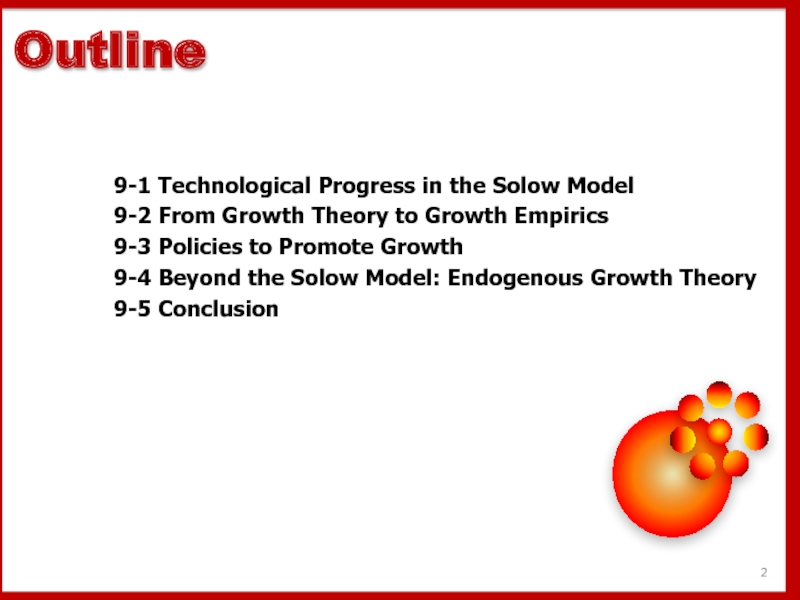
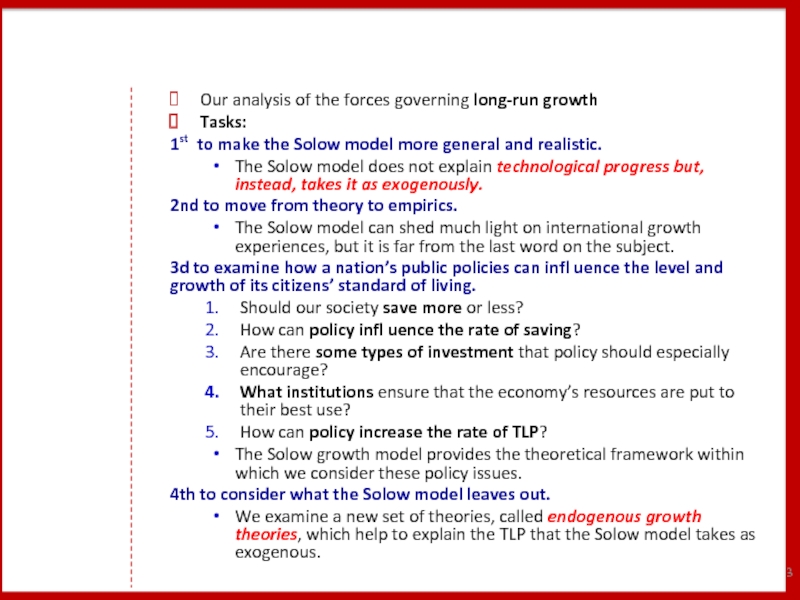
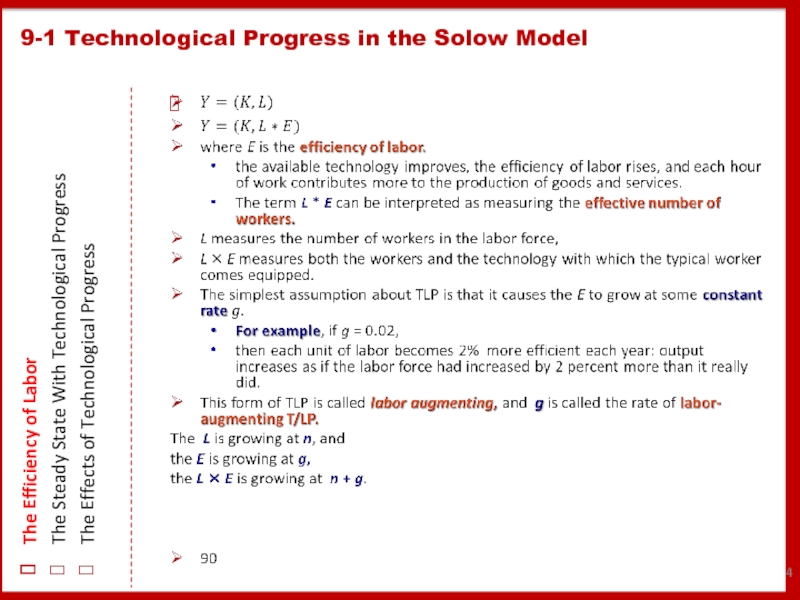
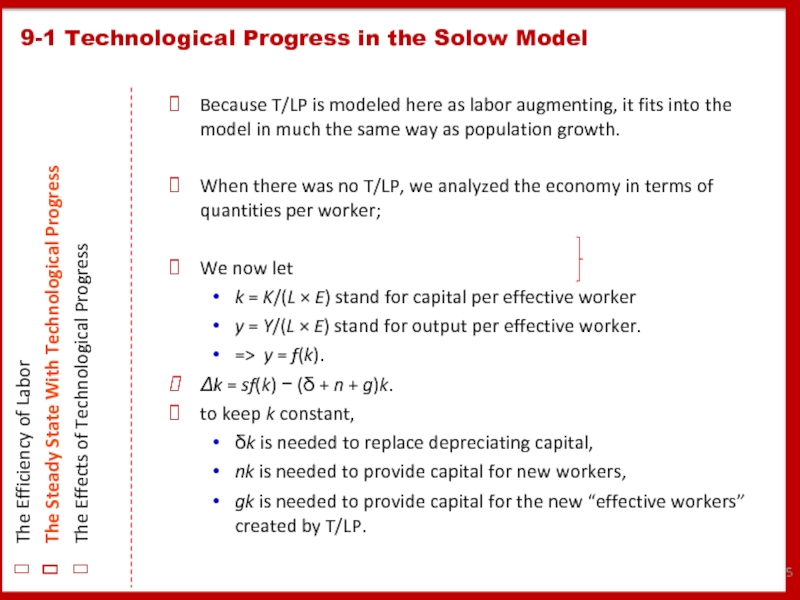
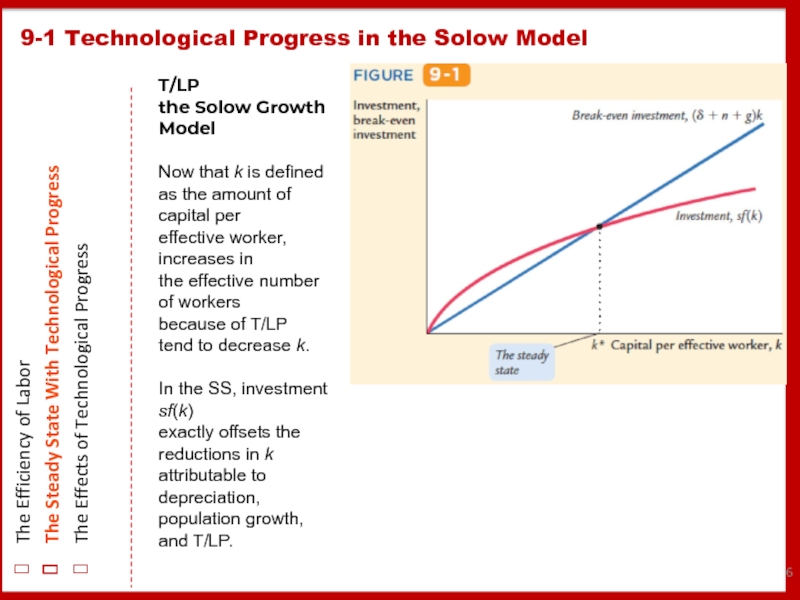
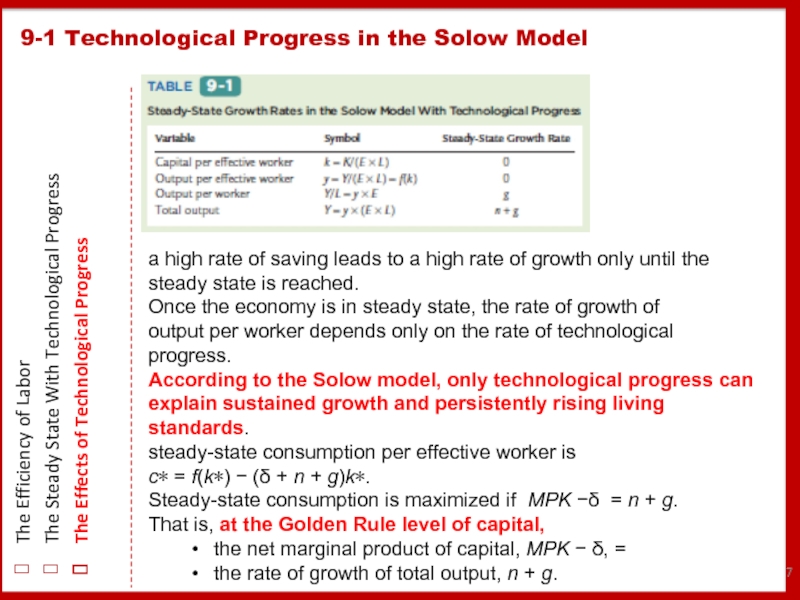
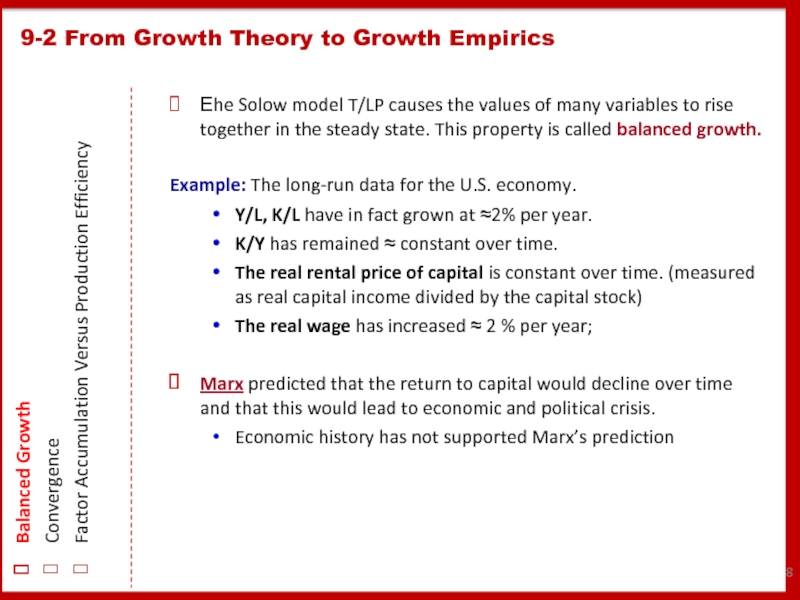
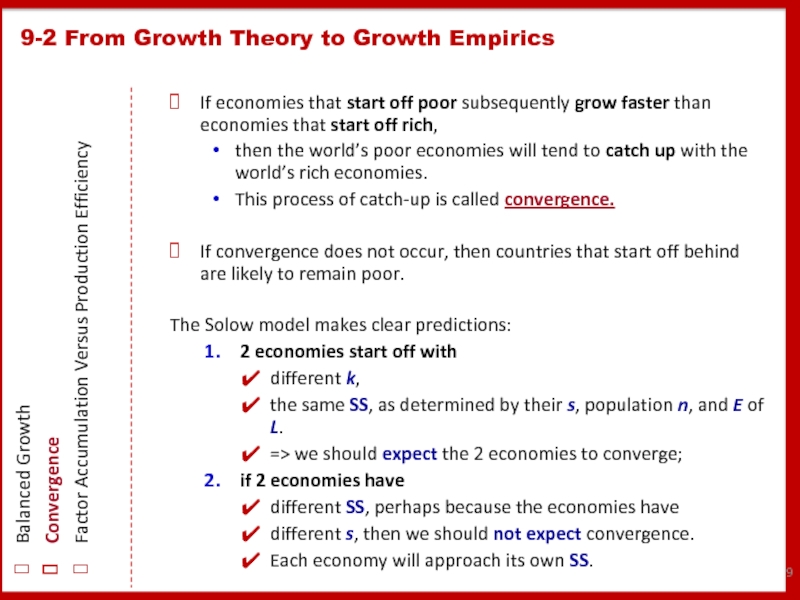
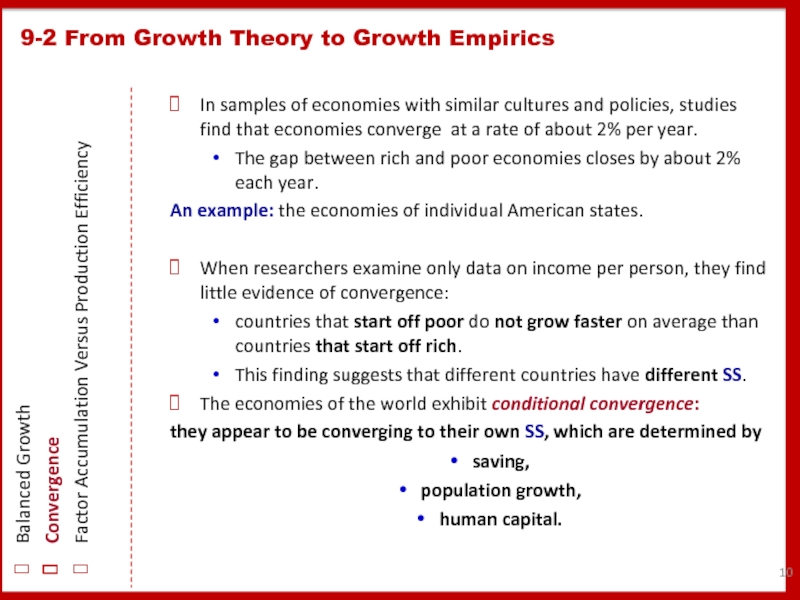
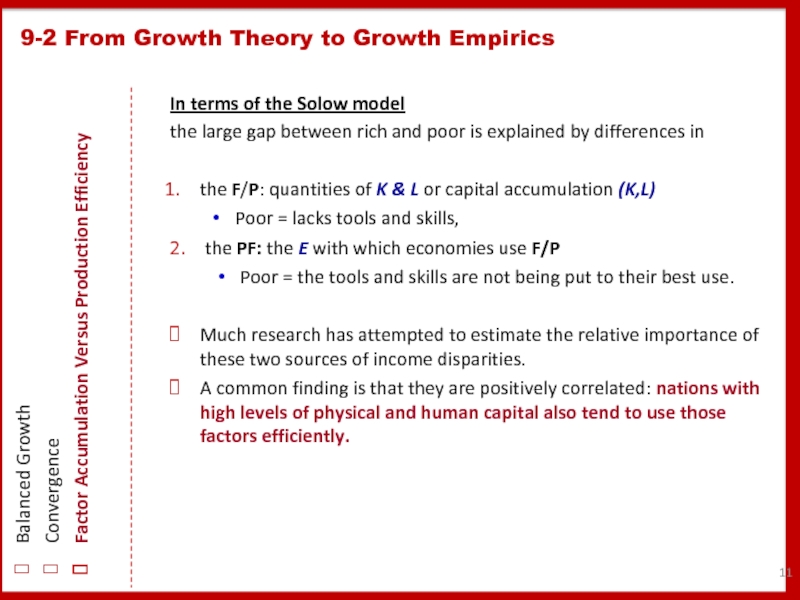
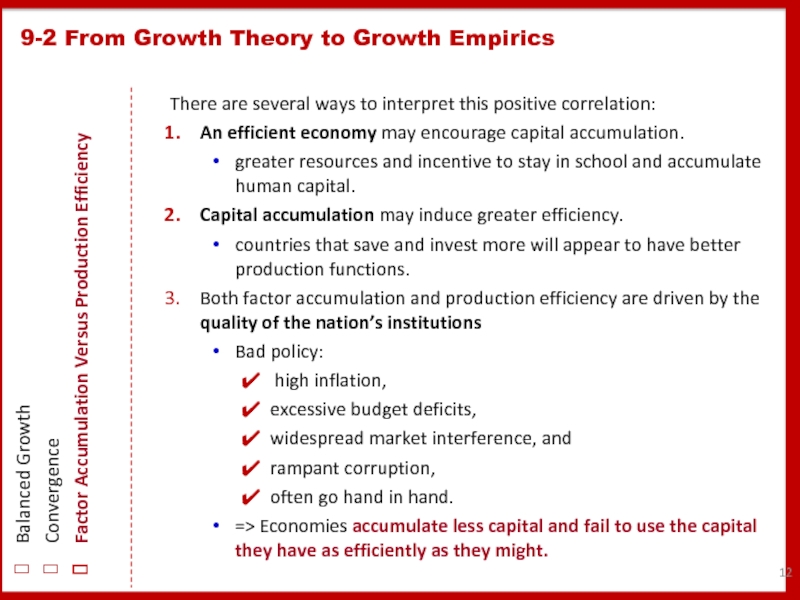
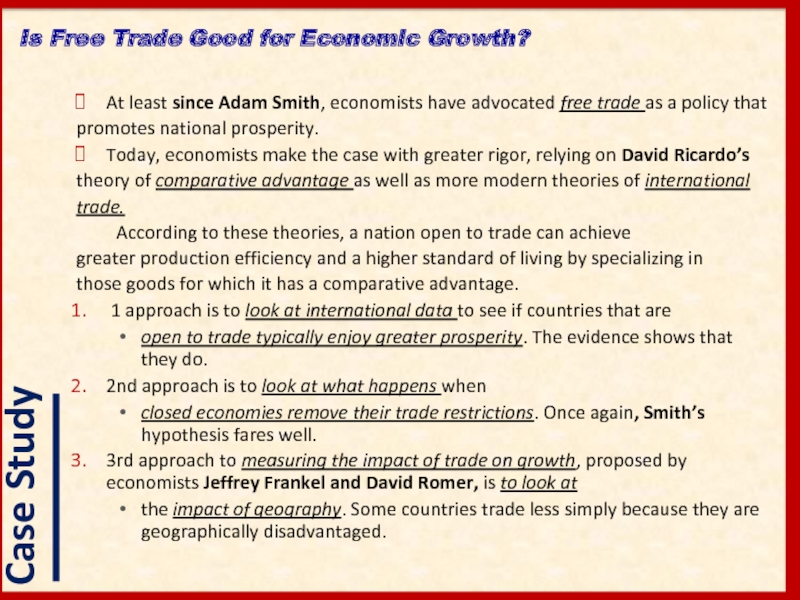
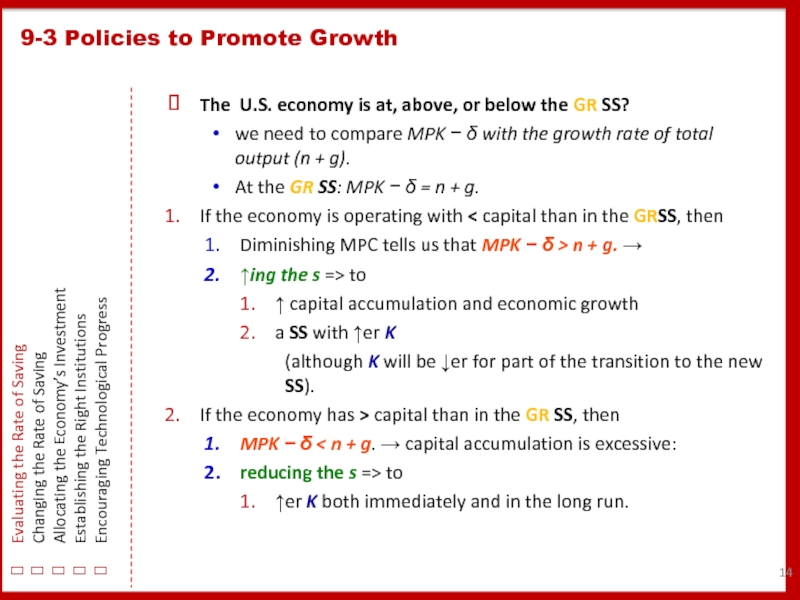
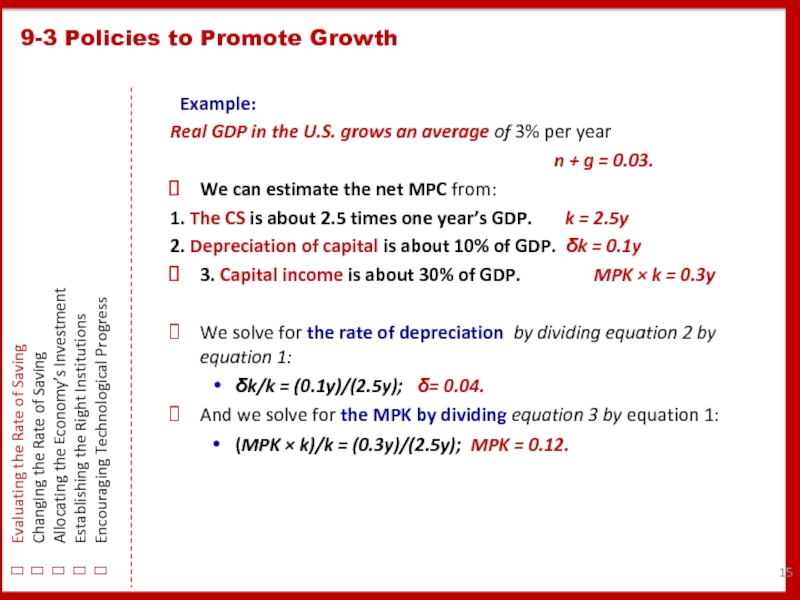
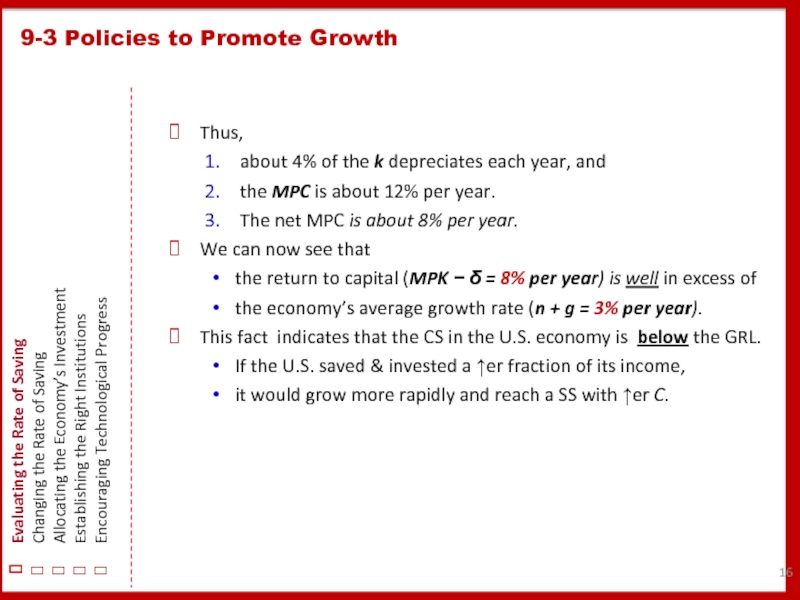
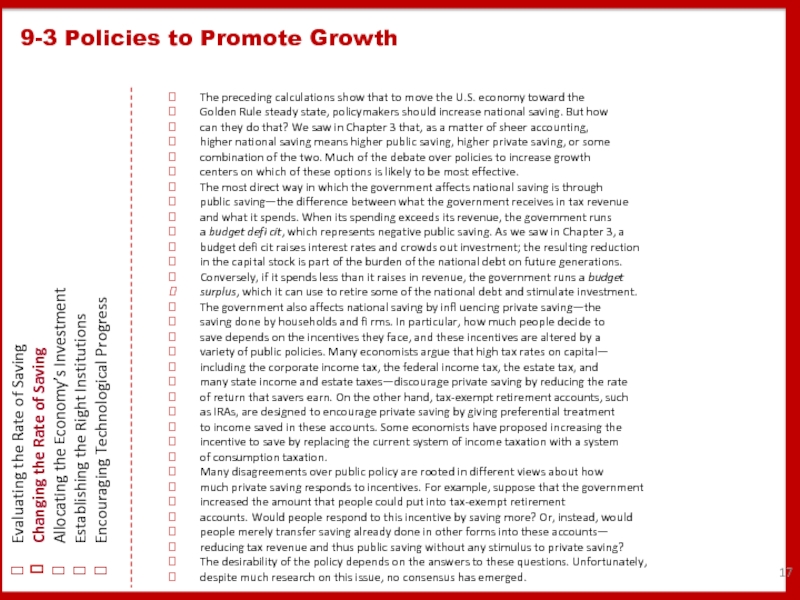
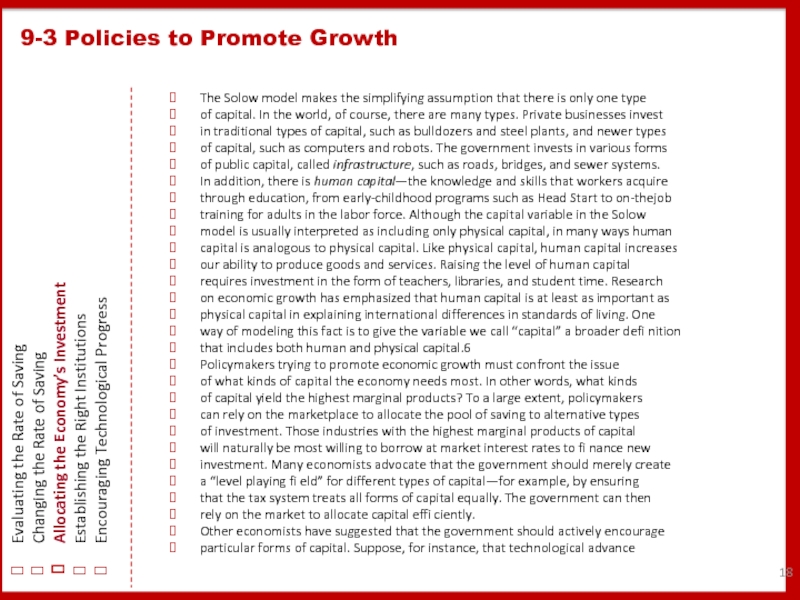
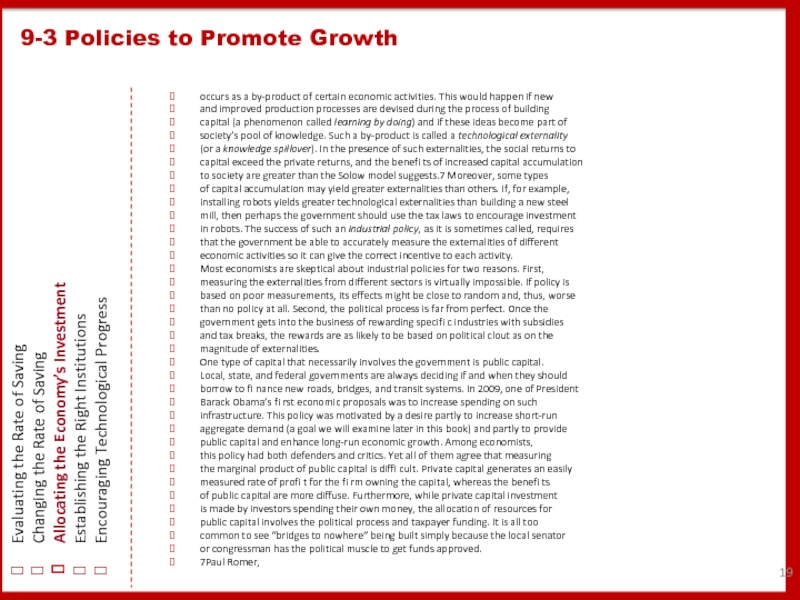
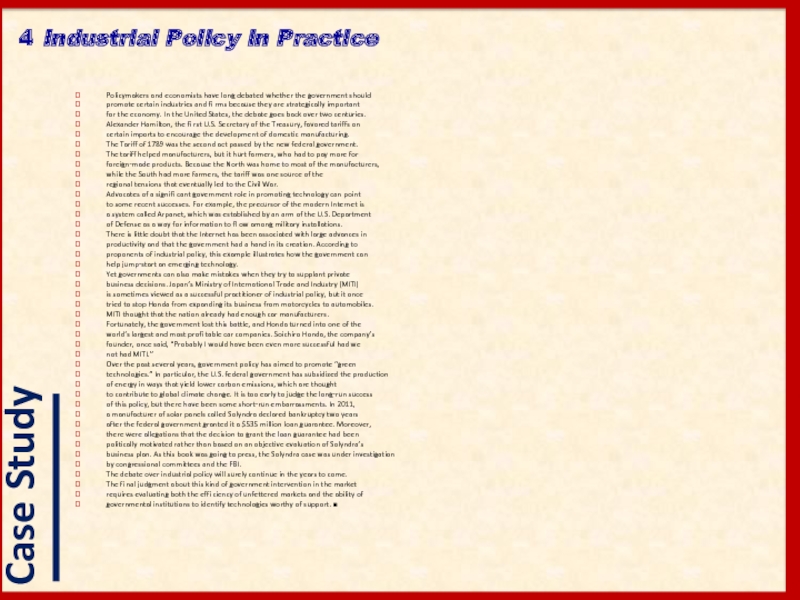
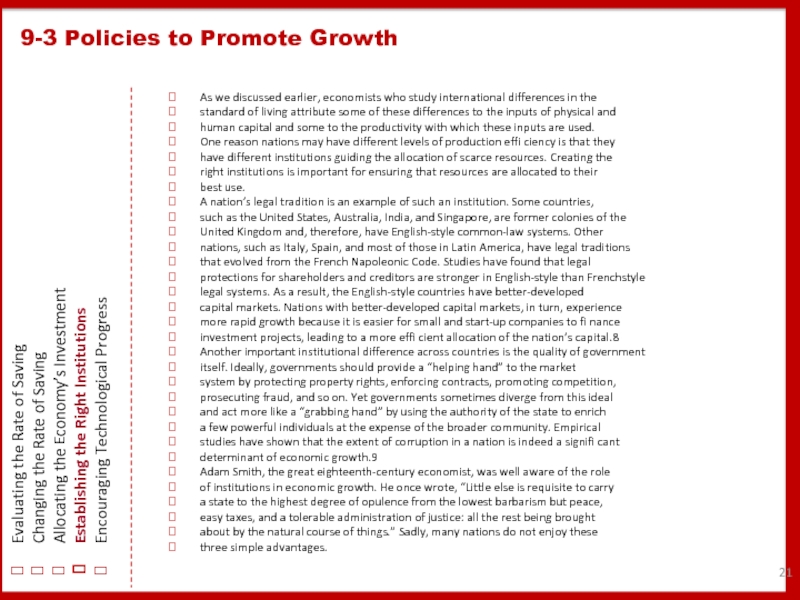
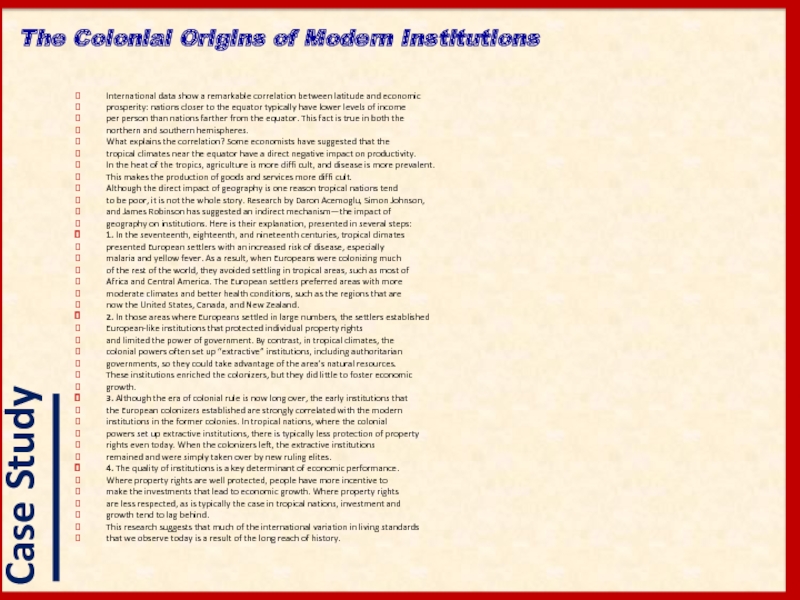
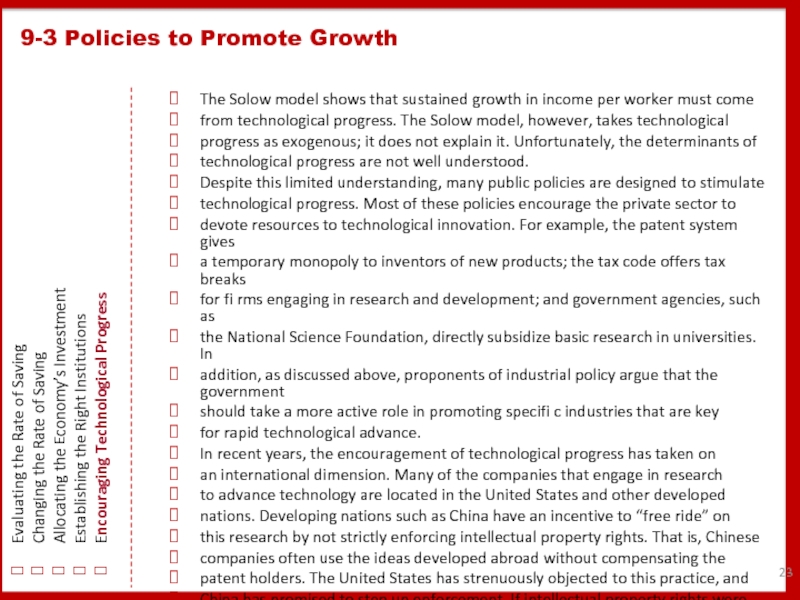
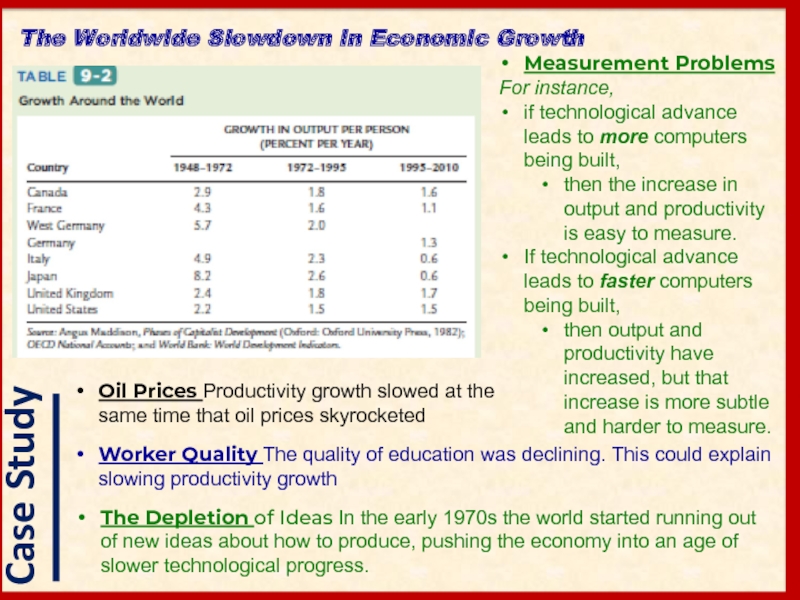
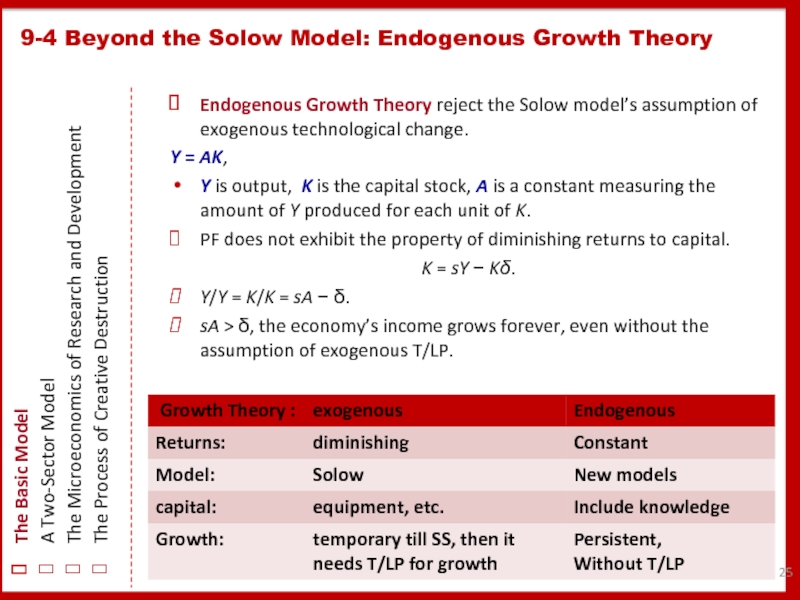
![Y = F[K, (1 − u)LE] (PF in manufacturing firms),E = g(u)E (PF in research](/img/tmb/1/32135/8fa53e4c96ec23d0d1fdc75733a02ba9-800x.jpg)
